What to do if an animal is poisoned with plant poison
If an animal ate a eucharis leaf, then sooner or later symptoms of poisoning appear. In some animals, they occur earlier, while others, on the contrary, look healthy for a long time. A small amount of toxin may not cause symptoms.
But toxins tend to accumulate in the body. When their concentration reaches the limit, poisoning occurs. In case of vomiting, depression, salivation and diarrhea, it is necessary to urgently deliver the animal to the veterinarian.
It is advisable to explain to the doctor which plant caused the poisoning. The subsequent treatment will depend on this.
It is advisable to provide the pet with first aid before the trip. It is necessary to empty the stomach by inducing vomiting. To do this, a little table salt is poured onto his tongue root. Then it is advisable to give an adsorbent to neutralize the poisonous substance in the stomach.
Reproduction of Eucharis.
Eucharis reproduces by dividing the bush.
Eucharis reproduces both by seeds and by children. The first method is quite laborious, and requires not only effort, but also patience, since the seedlings will bloom no earlier than 5 years after planting, therefore, the preferable way of reproduction of Eucharis is with children.
Eucharis over several years (sometimes during a dormant period) overgrows with a large number of children, and then they can be planted in different pots - divided. Many people ask to what depth to plant the Eucharis bulb? Different breeders have different opinions, but the best option is to look at the condition of the bulb itself. For example, if a bulb with leaves, then it is planted 5-10 cm (depending on the size of the bulb), but if the bulb is without leaves, then it is planted so that 1/3 of the bulb looks out of the ground - for your convenience, so you will be able to observe its condition, since the plant is very painfully undergoing a leafless state.
Taking care of Eucharis is not difficult, it is especially pleasant when the plant thanks you back with a beautiful flowering.
Eucharis: features of care after flowering
After flowering, eucharis must provide a full dormant phase, which lasts about one and a half months.
It is at this time that the plant gathers strength for future growth and flowering. Therefore, the intensity of its development in the next season directly depends on what kind of care will be provided to the Amazon lily at this time.
So, when the last flower is dry, the peduncles should be cut off (the leaves do not need to be cut off). The plant can then be moved to a less warm place and watering can be drastically reduced. Top dressing and spraying during this period should not be carried out at all.
In the resting phase, sometimes the leaves of the eucharis begin to turn yellow. Do not be afraid of this, the green mass will recover in speed.
The end of the dormant period is evidenced by the appearance of young leaves from the soil. As soon as this has happened, you can start again watering and fertilizing the eucharis, and, if necessary, raise the temperature to a higher one.
Did you know?
Sometimes flower growers manage to achieve eucharis flowering three times a year. In this case, the plant should also have three rest periods.
Eucharis, in a resting state, looks as attractive as in the growth period.
It is not necessary to move the plant to a cool place, it is only important to reduce watering and stop feeding
Taking care of the flower miracle
At home in South Africa, amaryllis is able to survive in difficult conditions. What rules should be followed? Caring for a delicate exotic comes down to three main requirements - temperature, humidity and lighting.For better growth and development, the indoor lily requires abundant lighting. The most suitable place for placement would be a balcony.
But you should avoid the scorching rays of the sun, this can lead to burning of the leaves. In winter, the temperature of the content should be no more than + 16 ° C. On especially hot days of summer, it is better to open the windows, since all houseplants love the flow of fresh air. Also from time to time you need to spray the leaves with water.
The plant needs regular irrigation with warm sediment water and fertilization. In winter, watering must be reduced, but the bulb must not be allowed to dry out. During this period, the soil should be watered rarely and in moderation. As soon as the flowering arrow begins to appear, the plant should be taken out to the balcony and begin to gradually increase watering, bringing it to abundant during flowering.
Fertilization should be done during the growing season 1 time in 2 weeks. The first feeding is applied before the start of growth, the second - during the formation of buds, the third - after flowering. For this, liquid mineral fertilizer is used. A room creature will be more hardy and strong if wood ash is periodically added to the ground. It is characterized by a rich content of easily soluble microelements, which are so necessary for ornamental dwellers. suitable for many colors, but should be applied in moderation.
Planting "room lily"
It is quite simple to grow amaryllis at home, planting is carried out in early spring. It all starts with choosing a pot and soil. The pot should be about 20 cm in diameter and have sufficient depth, because this exotic has a highly developed root system.
For planting, a special substrate for bulbous, river sand, as well as light soil enriched with nutrients is used. Don't forget about the drainage system. Before planting, the drainage is poured onto the bottom of the pot with a layer of 2-3 cm, then the ground is 3-4 cm high.After that, the onion is placed, the roots are straightened and covered with the remaining soil to half the onion, the remaining half is sprinkled with river sand. When filling the container with earth, leave enough room for water. Amaryllis is planted so that the distance between one bulb and the wall of the pot is 2-3 cm.
Until the first green leaves, this delicate creature must be kept in a dark and cool room. After the emergence of shoots, the plant is transferred to a balcony or windowsill.
Drawing conclusions ...
If Amaryllis is properly cared for, it will not be affected by diseases and pests, and outwardly it will look healthy and strong. If you do not provide sufficient watering or waterlogging the soil, the leaves will become lethargic and pale. If the plant is in a cold, dark room or in a draft, then the flowers begin to darken. And, conversely, the petals turn pale from the excess of the sun.
You should carefully monitor how your indoor inhabitant looks in order to take all the necessary measures in time. And then bright beautiful flowers and delicate aroma will charm you and your family for a long time.
Reproduction of the eucharis flower
Eucharis can be propagated in several ways, namely:
Leaves. Growers rarely use propagation by this method, which is due to the low probability that the material will take root and take root.
Children. This breeding option has gained popularity due to its ease and speed.
In order to propagate eucharis in this way, the baby bulbs must be carefully separated from the mother bulb. Damaged bulbs will not sprout, therefore it is better not to plant them.
Intact bulbs are planted in pots with a pre-prepared substrate of leafy soil, peat, sand and processed manure
The bulbs are placed at a depth of about 6 cm so that the top is not covered with earth. Subject to all the rules, new leaves will appear after a month and a half. After the plant has left its leaves, it must be fertilized.
Fertilizers alternate: organic and mineral in a week
It is also very important to choose the right pot for planting young bulbs. The flowerpot should not be too large, as in this case the process of rooting and growth of a young flower may be delayed.
Experts recommend providing the child with sufficient light without direct sunlight. In the future, a young eucharis is looked after in the same way as an adult.
Seeds. After pollination, bolls with dark seeds of a long shape appear from the flowers, which are used to reproduce the flower. For cultivation, it is necessary to use fresh seeds, which are planted in a substrate of peat and sand.
The pot with seedlings is covered with foil and placed in a place with room temperature and partial shade. In order for the seedlings to germinate faster, use the bottom heating. They also need to be regularly sprayed with warm water and allowed to air for several hours a day. Young plants germinate better in constantly moist soil. You can transplant when they have several leaves. Such a flower grows for about 4-5 years.
By dividing the mother's bulb. The method is most often used exclusively by experienced specialists, which is associated with the high labor intensity of this method. For reproduction, it is necessary to divide the mother bulb into 4 parts with a small cut. After that, each part is fixed with wooden sticks and the bulb is looked after as usual. After a while, 4 separate bulbs should form, from which full-fledged plants will grow.
It will also be interesting: Hippeastrum and amaryllis - differences and care for indoor plants?
Eucharis: growing and care at home
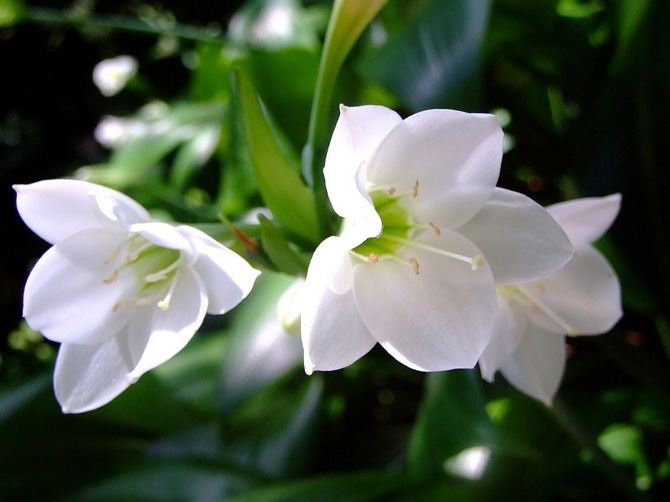
Location and lighting
Taking care of eucharis is very easy. As for lighting, the plant can grow and bloom in any room, on window sills and windows even on the north side. But, despite such unpretentiousness, it is impossible to argue that the plant loves the shadow. For example, if the room is on the north side, then you need to place the eucharis as close to the window as possible.
If the size of the window sills allows, then you can put the pot on them. The plant should always receive as much light as it needs. But it should be remembered that direct sunlight, especially from the east and south sides of the windows, can harm the leaves in the summer. The sun's rays can scorch the leaves. If there is such a risk, then it is better to place the flower pot not in front of the window, but for example, on the side.
Temperature
The temperature at which eucharis should grow and bloom is from 18 to 22 degrees. Those. at normal room temperature, the flower will feel comfortable. You should be aware that temperature changes (7 degrees or more) will lead to the fact that the flowers will be much smaller than usual. There is a high probability of this when the flower grows outside, and the temperature drops during the day and at night are very noticeable.
In winter, the optimum temperature for a plant is 15-17 degrees. But again, it is worth watching the development of the eucharis and see what temperature is most suitable for the growth of the flower. During the growth period, the temperature should be 18 degrees and not lower.
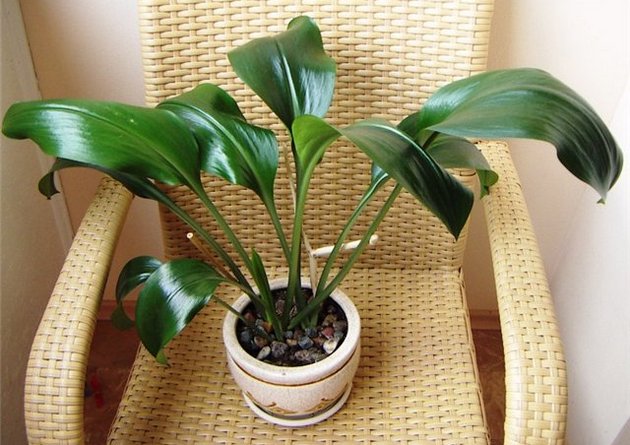
Watering
This is one of the most important aspects of eucharis care. Indeed, the success of growing a plant at home depends on proper watering. So, you need to water the plant quite rarely and only when the soil is completely dry. Stagnation of water can be fatal for eucharis. It will promote root rot and further plant death.
You need to learn how to properly water the plant. Eucharis is better to water rarely than abundantly and regularly. A flooded plant is much more difficult to save than a dried plant. After flowering, watering stops, and rest occurs.
Dormant period
The dormant period is very important for the plant. It is during this time that he is gaining strength for growth.After flowering, dried peduncles are carefully removed, while in no case touching the leaves. At rest, eucharis does not lose its decorative effect, but only passes from one stage to another.
The rest period lasts about a month. It usually falls between April and October. However, if the plant is properly and thoroughly cared for, it can bloom three times a year. Sometimes the plant has three dormant periods per year.
During the dormant period, you can safely move the plant to another cooler place. However, this condition is not necessary for the successful development of the plant. After a dormant period, when young sprouts appear on the eucharis and their active growth begins, watering resumes.
Top dressing
Eucharis should be fed exclusively in summer and only when the plant is actively growing. It is imperative that you familiarize yourself with the composition of the fertilizer before feeding. You need to choose a fertilizer with a low nitrogen content.
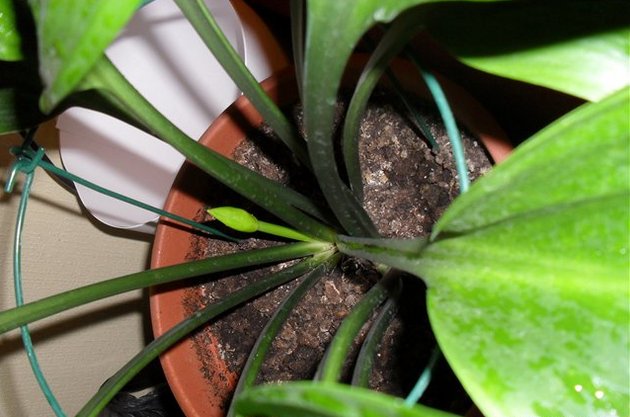
Transfer
Quite often, novice gardeners are faced with a problem when the eucharis does not bloom due to the fact that the pot is too spacious. You should know that eucharis will fully develop and bloom only in a cramped pot. It is recommended to transplant eucharis no more than once every three years. To do this, you need to select the following composition of the earth:
- 2 pieces of compost soil
- 1 part peat
- 1 part coarse river sand
For a successful transplant, it is important to provide the soil with good drainage.
Diseases and pests
The most common reason for the appearance of pests on eucharis is an increased temperature, accompanied by low air humidity. The flower can be attacked by spider mites and aphids, as well as scale insects with thrips. Their main effect extends to the plates - depriving of cell sap, the leaves turn yellow, then dry up and fall off. To save the plant, the first step is to eliminate all insects using a soapy sponge.
Next, you need to make a solution of "Actellik", diluted in a ratio of 1-2 milliliter of substance per liter water, and then spray.
Other insecticides will also work in this case. As a further prophylaxis, it will be necessary to balance the care and adjust the conditions of detention. If yellowish-white spots appear on the leaves, and the plates themselves dry out, then the effect of a spider mite is likely. Of course, the presence of cobwebs on the bush is an even more "screaming" signal. The cause of the mite is dry air and sick neighbors nearby, and the situation is corrected with the help of special spraying.
As for diseases, most often eucharis suffers from gray rot, which occurs with high humidity and low temperatures. Having noticed the first signs of the disease, the first step is to reduce irrigation and treat the plant with an appropriate preparation, for example, Bordeaux mixture. The damaged areas are immediately eliminated, and the wounds are covered with a special complex action preparation containing copper in its composition.
Rotten bulbs and rotting roots are the result of excessive moisture or cooling of the soil. Since the rot spreads along the bottom of the container, it is rather difficult to intervene promptly in correcting the problem.
When do the buds appear?
Eucharis bloom usually occurs in spring and autumn. And when flowers appear at a house plant, it can be considered a real holiday. The flower buds resemble daffodils, but they are much more graceful and the aroma emanating from them can be compared to a delicate floral perfume.
It is impossible to say that the Amazonian lily will often delight you with flowers. And although according to some associations its flowers are called Christmas, there are more chances to admire them in February-March. The plant develops a long stem with a bunch of lush, elegant flowers that open one after the other.
If the conditions for flowering are favorable, eucharis can form 2 peduncles or even more.And if an experienced florist has learned to "understand" the Amazonian lily, she can delight him with flowers up to three times a year: this happens in May, in the last month of summer and in one of the winter months.
The flowers of the Amazonian lily open in turn, each flower lives for a week (or a little more), the whole inflorescence blooms for 20 days. If the flower is large, then up to 8 peduncles can form on it, although these cases are rare. It is impossible to prolong the eucharis bloom itself, although many growers would like to do this.
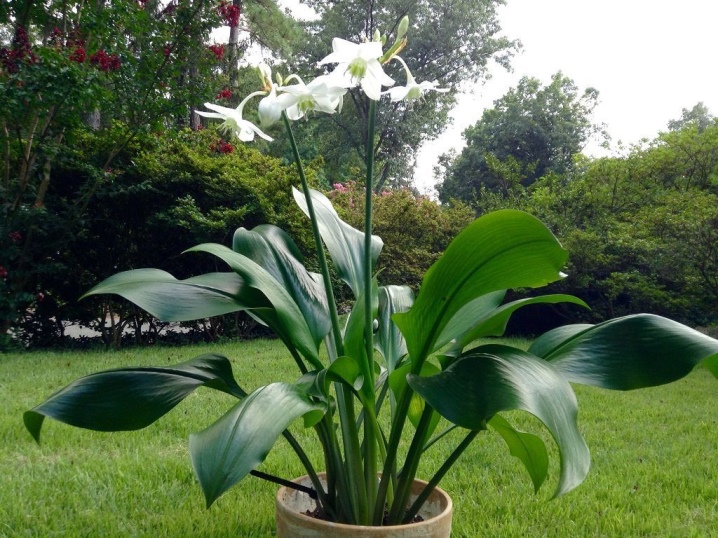
After flowering, the plant needs a dormant period: during this time, the Amazonian lily gains strength in order to optimally approach the new active stage. And if the breeder begins to overstimulate the flower, he will simply postpone the dormant period, the plant will increase the green mass. But it will not bloom, no matter how you stimulate.
This means only one thing: the flower, like all life on earth, obeys natural cycles. And if you do not interfere with these cycles, if you do not roughly interfere with the life of a flower, it will delight you with wonderful flowering periods and stable periods of rest.
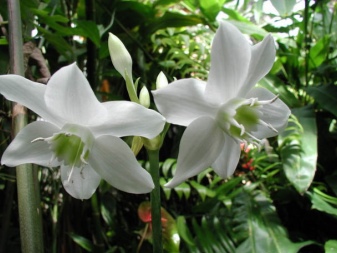
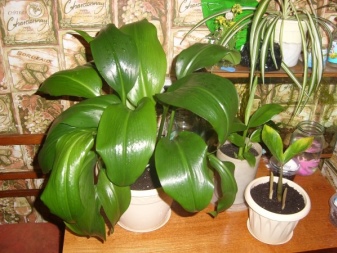
Features of caring for tropical eucharis at home
Despite the fact that eucharis belongs to the tropical species, it is not difficult to care for it at home. The only prerequisite for growing it is the presence of a large amount of free space.
So that you do not have any questions regarding caring for the Amazonian lily, we suggest that you familiarize yourself with the main nuances of caring for a plant in more detail (Figure 2).
Lighting
The advantage of eucharis is that it does not have a high demand for light. It will grow well and bloom successfully both in diffused light and in a lack of lighting (for example, on a northern windowsill). The only condition is not to expose the flower to direct sunlight, as this can burn the leaves.
 Figure 2. The main stages of flower care
Figure 2. The main stages of flower care
In summer, the plant can be taken out into the open air, but care must be taken that the eucharis is not exposed to direct sunlight and precipitation.
Air temperature
Eucharis is a thermophilic plant. During the period of active growth of the culture, it is undesirable for the temperature to drop below +18 degrees, as this can provoke leaf fall and bulb rot.
If you want to stimulate the bud formation process, you should provide the flower with more warmth and light. However, it should be borne in mind that sharp and strong temperature changes can lead to the fact that the flowers are too small.
Air humidity
Since eucharis is a resident of the tropics, one of the key conditions for its successful cultivation should be optimal air humidity. To do this, during the period of active growth, it is necessary to regularly spray the plant, but this procedure must be completely stopped during the flowering period.
In addition, dust should be periodically removed from the aerial parts of the plant. This can be done with a damp sponge. Such a procedure will not only increase the humidity of the air, but also prevent the spread of diseases and pests.
Watering
Eucharis should be watered regularly, but in moderation, since the plant does not tolerate both waterlogging and drying out of the soil.
To determine the optimal time for watering, you should check the moisture content of the substrate in the pot. When it dries up by a third, it is necessary to add moisture to the pot. It is impossible to allow the soil to completely dry out, as this will lead to drying out of the roots and can cause the death of the culture. But excessive watering is also very harmful for eucharis, since excess moisture can cause rotting not only of the roots, but also of the bulbs.
It is better to put the pot with eucharis in a tray, into which excess moisture will drain in the future. When the tray is full, it must be cleaned of water and wiped dry.
Soil composition and choice of pot for growing
The soil for growing eucharis should be loose and allow water to pass through well. You can buy such a soil in a specialized store, but, if you wish, you can do it yourself. To do this, mix 4 parts of leafy soil, 2 parts of compost and sand and 1 part of sod land and clay.
The pot for growing a flower can be anything. The only condition is the presence of drainage holes in the bottom, through which excess moisture will drain into the pan. In addition, when planting eucharis on the bottom of the container, it is imperative to lay out a drainage layer.
Fertilization
Fertilizers are applied only during the period of active growth and flowering of the crop. To do this, use special mineral dressings for flowering crops, and they must be diluted in water in accordance with the instructions.
Fertilizers are applied regularly, every two weeks. After the end of the flowering period, feeding is completely stopped.
Diseases and pests
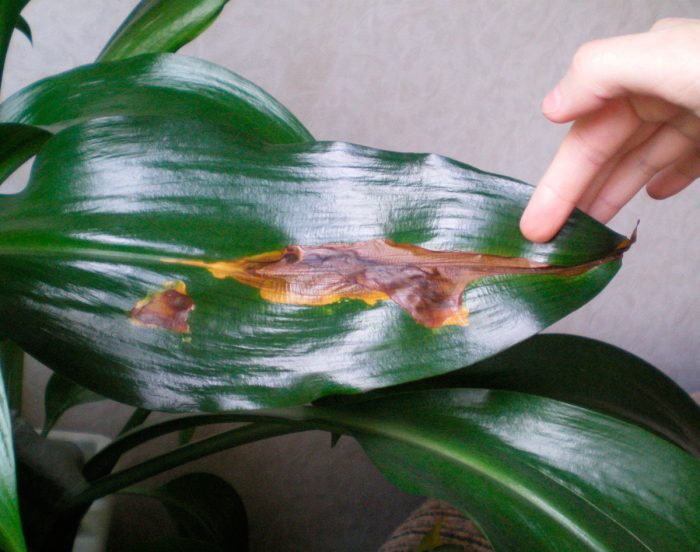
Pests
Eucharis has a fairly high resistance to pests, however, scabbards, thrips or spider mites sometimes settle on it. Most often, those plants that are not properly cared for suffer from them. In order to exterminate such insects, you will have to spray the bush with a systemic insecticidal drug (for example, Fitoverm or Aktellik), they can be found on the shelf of any specialized store. However, it is better to provide the plant with proper care and optimal conditions for growth, then pests will bypass it.
Diseases
Most often, the culture suffers from gray rot. As a rule, the development of such a disease is facilitated by high humidity in a cool room. As soon as you notice the first signs of the disease, it will be necessary to sharply reduce the watering, then the bush is sprayed with a solution of the agent used to combat gray rot, for example: Champion, Bordeaux mixture or Topaz (at the initial stage of the development of the disease). All severely affected areas on the bush are cut out to healthy tissue. In this case, it will be necessary to treat the wounds with a contact agent containing copper, for example: cuproxate, copper sulfate or oxychom.
Possible problems

If such a plant is improperly taken care of, then problems may arise with it:
- Eucharis does not bloom. If you take care of the bush correctly, then it will bloom 2, and sometimes 3 times during the year. However, it happens that the eucharis does not want to bloom. To fix this, you first need to understand why this is happening. In order for the transplanted cut to bloom as soon as possible, it should include several bulbs. This is because one bulb, planted in a separate pot, will not bloom until many children have grown, and this usually takes 3-5 years. This is the most common reason for the lack of flowering. Another bush may not form flowers due to sudden changes in temperature or drafts. In this case, it will be enough to start caring for the plant correctly, and it will bloom regularly again.
- How to make it bloom? To do this, for the winter, the bush is placed in a shaded and cool place, watering is greatly reduced (the clod of earth in the pot should dry out almost completely), and you should also stop fertilizing the soil. As a result, with the onset of spring, the bush will begin to grow actively and will certainly delight you with lush flowering.
- Yellowing of foliage. In the event that only one or two sheet plates have become yellow, then this is a completely natural process. But if the foliage turns yellow massively, and even spots of a dark color appear on its surface, this means that urgent measures need to be taken to save the flower. Yellowing of the foliage is observed when: the plant does not have enough water due to excessively scarce or rare watering, liquid regularly stagnates in the soil mixture, and also due to hypothermia of the bush.
- Fly around foliage.In the case when the foliage not only turns yellow, but also dies off, it is necessary to remove the bush from the pot and carefully examine its root system. Cut out any areas affected by rot and apply charcoal powder to the wounds. After that, the bush is planted in a fresh substrate. At first, the eucharis should be warm, and it is also provided with moderate watering and reliable protection from direct sunlight. If there are no rotten areas on the root system, then foliage flying around is associated with improper care.
HOW TO MAKE EUCHARIS FLOWERS
Fertilizing and transplanting Eucharis.
Transplanting Eucharis bulbs.
Eucharis is fed only in the phase of active growth, which, as a rule, occurs in the summer. Fertilizer can be bought universal for feeding bulbous plants, most importantly, with a low nitrogen content.
Eucharis is transplanted according to my growth, preferably no more than 1 time in 3 years, since the plant is very painfully experiencing this stress. You can buy ready-made soil for transplanting, or you can make it yourself from earth, peat and coarse river sand in a ratio of 2: 1: 1. When transplanting, at least 4-5 bulbs are left in the pot, Eucharis does not bloom alone, so at first it will take time to grow over with children, and only then you can wait for flowering. The pot is chosen not too close, but not wide, otherwise the Eucharis bloom can also not be expected. At the bottom of the pot, you should definitely put a layer of drainage and only after that the soil. When to transplant Eucharis? In the phase of his rest, that is, after the flowering of the plant, at this time he is most optimally experiencing stress.
General description of the plant and its types
The homeland of a plant called Eucharis is South America. This plant belongs to the Amaryllis family. It has a fibrous root system and a modified stem - a bulb. Its leaves are arranged on long petioles.
The leaf blade is oval, up to 30 cm long and 12-15 cm wide. The leaves of the plant are glossy, dark green in color. Eucharis blooms with large white flowers no more than 12 cm in size. They are located in 5-6 pieces on a peduncle. The eucharis peduncle reaches a length of 80 cm. Each flower has 6 petals.
There are more than 20 types of eucharis. The differences between them are minor. The following types of eucharis are grown at home:
Eucharis large-flowered - has bulbs up to 5 cm in size, dark green leaves and long peduncles, on which there are up to 6 flowers. The most common type, it begins to bloom in early summer and late November;
- Eucharis white is the most compact species with oblong bulbs, elongated leaves, tapering at the ends. It blooms with small flowers 5-7 cm in diameter, on one peduncle there are up to 10. Flowering begins in March and October;
- Eucharis Sandera - the species is distinguished by large bulbs, reaching a diameter of 7 cm.The plant is lush, with many leaves. The flowers are white and medium in size. The size of the flowers depends on their number on the peduncle. Blooms in February and September.
Below are photos of the varieties of the Eucharis indoor flower (Amazon lily):



Eucharis Sanderi
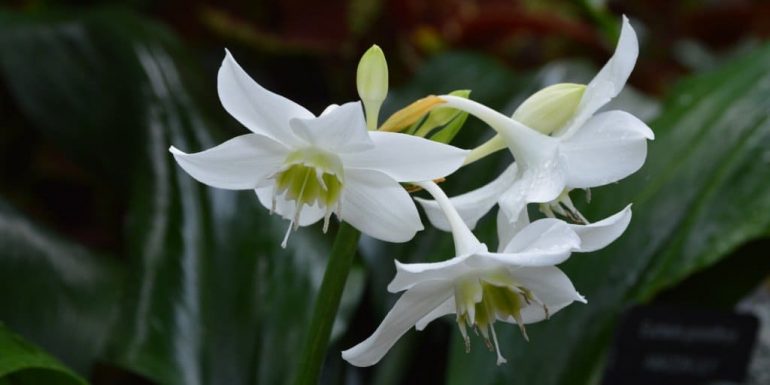
Dense leafy plates with long petioles are bright green in color. Their width reaches 150 mm. On the peduncle, up to 3 - large, less often - up to 6 - small white flowers with a lemon "crown" are formed. Blooms in early spring.
Eucharis large-flowered
One of the most common types of Amazonian lily for home keeping.
It blooms in late spring, summer and winter. The flowers unfold alternately, which makes the flowering process smooth and harmonious. It has paired leaves, their length can reach up to 40 centimeters, which is why this species is called large-flowered.
This plant requires a lot of space in the house, but it still remains unpretentious to maintain.
Eucharis White
It is a mountain variety of the Amazonian lily. The birthplace of the flower is Colombia, or rather its mountainous territories.
The flowers are smaller than those of the large-flowered, but there are more of them in the inflorescence - up to 10.
For reference! The peculiarity of this species is that the petals of the flowers are directed upwards. It blooms in autumn and March.
Eucharis toothless
Comes from Colombia, like eucharis Mastersa. A distinctive feature of this species is the leaves of a triangular shape. Their length does not exceed 20 centimeters, and the width is 10. Flowers in the inflorescence are usually 7-10 pieces, they open in the form of umbrellas. This eucharis blooms in mid-spring.
The most unpretentious in care are the types of Sander and large-flowered, it is on them that the choice of flower growers from all over the world falls.
Eucharis Mastersa
This species also comes from Colombia. Outwardly, it does not differ much from the white eucharis - the leaves are green and rounded, the flowers are small, white, grow in the form of umbrellas.
Usually two inflorescences bloom at once. The flower petals are rounded and taper towards the base. Blooms all spring - from March to May.
Growing conditions
It is necessary to immediately mention that the conditions of "habitation" of the eucharis at normal times and during the dormant period are different, and in the second case, everything becomes more simplified. The plant needs to gain strength and prepare for the growth of green mass and the appearance of flowers. At the end of autumn, it is required to cut off the spent flower stalks, then reduce irrigation and, if possible, move the pot to a room with a lower temperature.
Lighting
It is believed that eucharis is able to develop in absolutely any room. However, the quality of its growth will differ depending on the lighting - in a light room, the flowering will be more abundant, and on the windowsill of the window facing north, it will be more modest. The plant will not like exposure to direct sunlight. Under natural conditions, culture develops in mountain forests, and therefore can calmly grow in the depths of the room. In general, the sill of a window looking either west or east, and therefore devoid of the midday sun, is considered ideal for him.
When eucharis is carried out onto the balcony in summer, it needs to provide additional shade. After the plant has grown so much that it no longer fits on the windowsill, it is allowed to place it either between window openings or on a stand next to the window. If the north side is selected, then the pot will have to be placed as close to the light source as possible.
In any case, it is important that the eucharis receives the required amount of illumination, but the foliage does not get burned. The plant reacts best to diffused lighting or light partial shade.
Bulbous culture needs the same lighting throughout the year, so already in October it should be placed closer to the window. In case of insufficient lighting, the plant does not build up its vegetative mass poorly and practically does not form peduncles, simply replacing the leaves.
Temperature
Eucharis feels great if the temperature does not go beyond 18-22 degrees. During the summer months, it makes sense to put the plant on the balcony, but only if the differences between night and day temperatures do not exceed 8 degrees. The optimal degree gap in the heat will be 25-30 degrees. In winter, if the eucharis decides to bloom, then the temperature will have to be maintained at at least 18 degrees. If the culture goes to rest, then the temperature can be reduced to 15-17 degrees.
The plant should not be in the fresh air when it starts to get colder at night, and even more so it should not be exposed to the first frost. As a timely prophylaxis, it makes sense at the end of August to organize a small greenhouse using polyethylene.
The soil
The soil for eucharis must be moisture-consuming and nutritious. The optimal composition can be obtained by combining 4 parts of leafy soil, a couple of parts of compost, part of a rotted mullein, a couple of parts of coarse sand and part of loam. A combination of leafy soil, turf, peat and coarse sand, taken in a ratio of 2: 1: 1: 0.5, is also suitable.We must not forget about the drainage layer created from stones or sand. Alternatively, you can use hydroponics.


